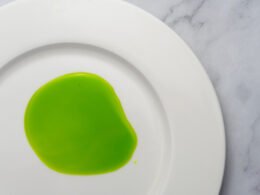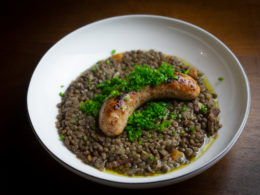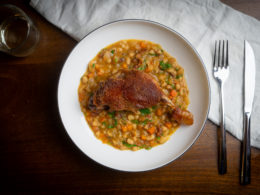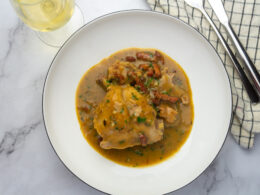This North Indian inspired lamb and chickpea curry is easy to make and incredibly delicious. It’s slow cooker and Instant pot friendly and is perfect to serve family style.
Lamb can be expensive so using canned chickpeas is a great way to bulk out the dish as well as being delicious (and authentic!).
Unlike many curry recipes, this one doesn’t have a huge list of spices – you’ll be able to find them all in your local grocery store. Give it a go and you’ll be rewarded with fall apart lamb in a thick, luxurious spiced tomato sauce.

How to Make Lamb & Chickpea Curry
Lamb and chickpea curry is an easy, delicious and cost effective way to eat lamb. It’s relatively straight forward but you’ll need to be patient.
1. Caramelize the Onions
One of the most important steps for a lot of curries is to properly caramelize the onions as a base.
Why? They bring an incredibly complex, sweet yet savoury flavour.
It’s an important step for this curry that shouldn’t be skipped. I’d generally try and cook them slowly for at least 45 minutes but if you haven’t got time, 15-20 minutes will do.
2. Bloom the Spices
Once you’ve caramelized the onions, cooked the ginger-garlic-chilli paste out, the next step is to ‘bloom’ the spices.
This just means toasting the spices lightly, on a low heat (remember not to burn them!), in oil for around 30 seconds.
Why? This really helps to bring out the flavours and adds even more depth to your curries. Click here to read this explanation by Serious Eats.
3. Slow Cook
The next step is to cook the lamb pieces low and slow in the spice, onion and tomato mixture. Just cover with water and let it cook slowly either in the oven or on the hob.
The lower and slower you go results in the most tender, fall apart lamb.
4. Blend the Sauce
The last part, before adding the chickpeas, is optional but I think you get a better, more restaurant-like result, is to blend the sauce.
Just remove the lamb pieces and blend the sauce with a hand blender or in a traditional blender.
It emulsifies the fat and creates a lovely thick, pourable curry sauce.
What Cut of Lamb to Use?
Most cuts of lamb are great to use in curries, you just need to avoid the expensive, lean cuts. I
- Lamb shoulder: This is my favorite cut to use for curries. Cook it long enough and you’ll be rewarded with cubes of tender, melting, fall apart lamb. It’s one of the cheapest cuts and certainly the most flavoursome.
Lamb shoulder tends to be sold on the bone – you can either remove it yourself or ask the butcher to do it. You can also add the bone to the curry for even more flavour.
- Lamb leg: Another really popular cut for lamb curries. Lamb leg is a lean cut but after a slow cook, it becomes really tender.
It’s slightly more expensive than shoulder but is generally more available. Like shoulder, it’s generally sold as a whole, bone-in leg – you can ask your butcher to debone it for you.
- Lamb neck: This cut is versatile, cheap and full of flavor. It can be difficult to find depending on which country you’re in. Cook it slowly and it becomes really tender and fall apart.
- Lamb shank: One of the favorite cuts of lamb for curries, lamb shank is incredible. Cooked on the bone, which adds a lot of flavour to the gravy, it becomes super tender after 2.5/3 hours. It’s a great cut to use if you’re making this recipe for for a dinner party as one shank is perfect for one person.
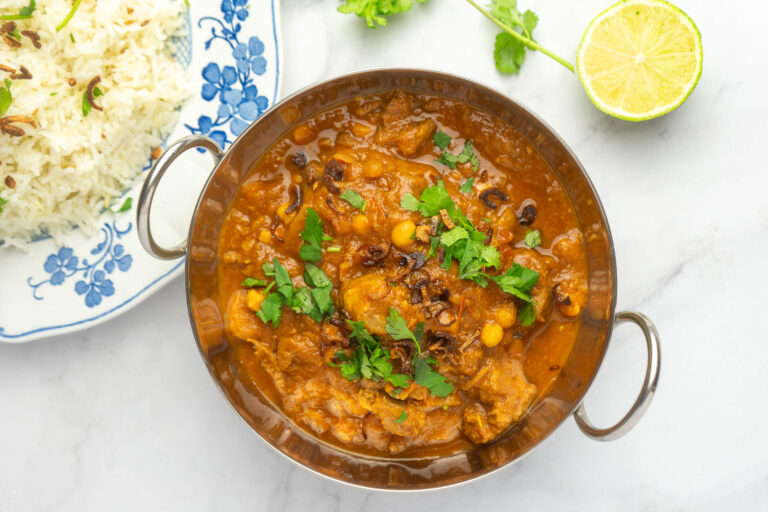
Northern Indian Style Lamb and Chickpea Curry
This North Indian inspired lamb and chickpea curry is easy to make and incredibly delicious. It’s slow cooker and Instant pot friendly and is perfect to serve family style.
- Total Time: 2 hours 30 minutes
- Yield: 4 1x
Ingredients
- 500g lamb shoulder, leg or neck, cut into 1.5 inch chunks
- 3 white onions, sliced thinly
- 5 garlic cloves, roughly chopped
- 1 thumb of ginger
- 1 red chilli (or more, depending on your preference)
- 1 can crushed tomatoes or passata
- 1 tin chickpeas (or any white beans of your choice)
- 1 tsp ground cumin
- 1 tsp ground coriander
- 1 tsp ground fennel seeds
- 1/2 tsp turmeric
- 1/2 tsp chilli powder (preferably Kashmiri)
- 3 cardamon pods, crushed
- 1 cinnamon stick
- 2 tablespoons Greek yoghurt
- 1 tablespoon sugar
- 1 tablespoon salt
- fresh coriander, as required
- 1 green chilli, finely sliced
- 10 dates, as required
Instructions
- Firstly, cut the lamb (either shoulder or leg) into 1.5 inch/4cm chunks and season liberally with fine salt. Let the lamb absorb the salt in the fridge for 20 minutes whilst you prep the rest.
- Next, prepare the ginger-garlic-chilli paste. Place them into a small pitcher with a splash of water and oil and blitzing with a hand blender until smooth. Alternatively you can use a mini food processor. You might need to add a bit more water depending on the size of your pitcher.
- Take the sliced onions and put them in a heavy bottomed pan on a medium heat with 1 tablespoon of oil. Stir regularly and make sure that they don’t brown. For best results cook for at least 45 minutes (see note 1) or until they’re sticky and have a rich golden brown color.
- Add the ginger-garlic-chilli paste and cook over a medium heat until fragrant.
- Add a splash more oil and add the spices, cook for 20-30 seconds or until fragrant.
- Add the lamb, tomatoes and stock. Bring to a simmer, cover with a lid and cook for 1.5 to 2 hours (see note 2).
- (Optional) Once the lamb is tender, remove the pieces (and excess fat with a spoon) and add the sauce to a blender and blend on high until smooth.
- Pour the sauce back into the pan along with the lamb. Add the drained chickpeas, yoghurt, green chilli and prunes.
- Cook for another 20 minutes and serve immediately.
Notes
Note 1: Ensuring the onions are deeply caramelised gives this curry the restaurant quality flavour. I’d recommend caramelizing them for at least 40 minutes for best results. If you’re short on time, 15-20 minutes will suffice!
Note 2: The cook time will depend on the cut of lamb. If using a slow cooker cook on low for 6 hours. If using an Instapot, cook on high pressure for 40 minutes.
- Prep Time: 30 minutes
- Cook Time: 2 hours
- Category: Mains
- Cuisine: Indian
What to Serve with it?
It’s perfect served family style, on a big serving dish with pilaf rice, roti or naan bread.









